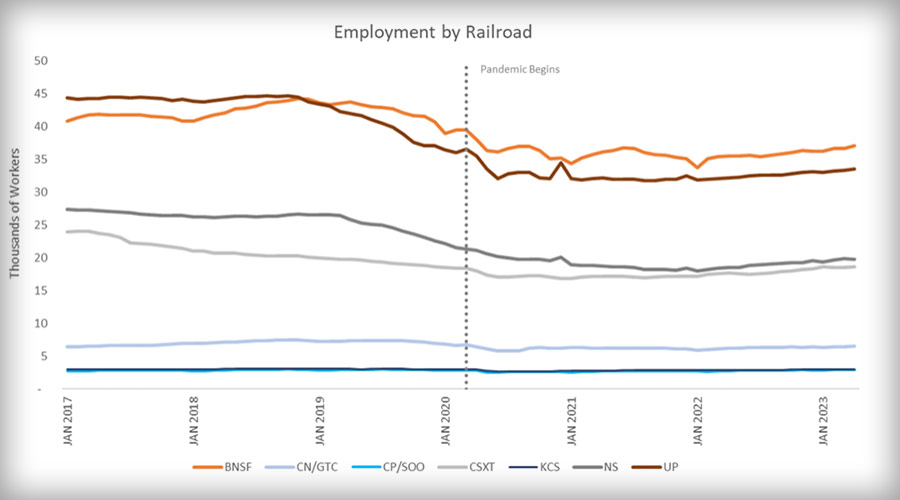FRA charts Class I employment trends; hiring remains 'problematic,' STB chair says
6/27/2023
By Julie Sneider, Senior Associate Editor
The Federal Railroad Administration recently charted Class I employment trends from January 2017 through April 2023. The charts show what has been acknowledged by the rail industry: Employment levels were already falling prior to 2020, but the decline accelerated once the pandemic began to affect railroad operations in March 2020.
The report, which charts employment trends from January 2017 through April of this year, is based on data the Class Is have been required to file monthly with the Surface Transportation Board. The data shows employment totals, as well as by the following job categories: executives and assistants, professional and administrative, maintenance of equipment and stores, maintenance of way and structures, train and engine and “other” transportation positions.
The largest category of employees is train and engine transportation, or the people who run the trains. That category is followed by the two types of maintenance; then professional and administrative; executive and, finally, “other” transportation positions.
“Employees in all job categories have seen decreases over time to varying degrees, with some having more pronounced decreases during the pandemic in 2020,” the report states.
Beginning in January 2022, employment levels began to climb toward pre-pandemic levels.
The FRA summary also charts trends by individual Class Is, both U.S.-based — BNSF Railway Co., Union Pacific Railroad, CSX, Norfolk Southern Railway and Kansas City Southern — and the Canadian Class Is’ U.S. operations. For CN, the data is reported under its Grand Trunk Corp.; for Canadian Pacific, under the Soo Line Railroad. FRA’s indicates employment trends for Canadian Pacific and Kansas City Southern prior to their merger.
By railroad, the data shows:
• BNSF in January 2017 employed 40,841 people; of those, 16,553 were T&E workers; in March 2020, 39,494 total, of which 15,794 were T&E; and in January 2022, 33,686 total, of which 13,682 were T&E.
• UP in January 2017 employed 44,392 total, of which 16,825 were T&E; in March 2020, 32,012 total, of which 13,598 were T&E; in January 2022, 31,800 total, of which 13,460 were T&E.
• CSX in January 2017 employed 23,879 total, of which 9,059 were T&E; in March 2020, 17,597 total, of which 7,054 were T&E; in January 2022, 17,158, of which 6,739 were T&E.
• NS in January 2017 employed 27,316 total, of which 11,157 were T&E; in March 2020, 18,445 total, of which 7,772 were T&E; in January 2022, 18,025, of which 7,372 were T&E.
• KCS in January 2017 employed 2,969 total, of which 1,208 were T&E; in March 2020, 2,888 total, of which 1,280 were T&E; in January 2022 2,909 total, of which 1,283 were T&E. \
• CN/GTC in January 2017 employed 6,413, of which 2,156 were T&E; in March 2020, 6,067 total, of which 2,318 were T&E; in January 2022, 5,938, of which 2,186 were T&E.
• CP/Soo in January 2017 employed 2,757, of which 1,085 were T&E; in March 2020, 2,700 total, of which 1,057 were T&E; in January 2022, 2,691, of which 1,045 were T&E.
 The graph shows Class I employment in the United States between January 2017 and January 2023. Federal Railroad Administration
The graph shows Class I employment in the United States between January 2017 and January 2023. Federal Railroad Administration Meanwhile, the STB last week posted Class I employment levels for May 2023, the latest data available. That data shows that U.S. Class Is employed 122,391 people in mid-May, a 0.82% increase since mid-April and a 5.72% increase since May 2022.
All categories reflected increases, both for month-over-month and year-over-year comparisons.
In May, the railroads employed 52,043 T&E employees, up 0.94% since April; maintenance of way and structures, 28,909, up 0.68%; maintenance of equipment and stores, 18,267, up 1.31%; professional and administrative, 10,089, up 0.49%; executives, officials and staff assistants, 8167, up 0.1%; and transportation (other than T&E), 4,916, up 0.51%.
Year over year, the increases per employment category were T&E, up 8.25%; maintenance of way and structures, up 1.92%; maintenance of equipment and stores, up 4.94%; professional and administrative, up 5.72%; executives, officials and staff assistants, up 6.24%; and transportation (other than T&E), up 4.75%.
U.S. Class I employment levels a sensitive topic
Class I employment levels have mushroomed into a controversial topic for rail unions, shippers and regulators over the past few years, as railroads adopted operating plans that called for reducing costs, improving efficiency, lowering their operational ratios and boosting profits. Those plans resulted in slashing about a third of the Class I workforce since 2017, a practice that shippers and rail union leaders have pointed to as a main factor in ongoing freight-rail service problems over the past two years.
Although Class I executives have defended their companies’ operating plans, they agreed that staffing shortages, particularly among train crews, were key to the service headaches. They also acknowledged that they further reduced train crew staffing in March 2020 at the start of the pandemic. But they also acknowledged being unable to rehire enough workers fast enough to accommodate the sudden surge in demand for goods as the economy — fueled by federal pandemic recovery funding — started to swing back from recession in May 2020.
 The graph shows Class I employment in the United States by job category, from January 2017 to January 2023. Federal Railroad Administration
The graph shows Class I employment in the United States by job category, from January 2017 to January 2023. Federal Railroad AdministrationIn 2022, the STB began monitoring more closely the railroads’ weekly rail service performance data after receiving numerous complaints from shippers about inconsistent and unreliable service from BNSF, CSX, NS and UP. The board required the four carriers to submit service recovery plans, weekly and/or biweekly reports on service performance indicators and updates on hiring trends. The board extended those service-related and employment reporting requirements a few times, with the last period set to expire Dec. 31.
During a recent speech to the North American Rail Shippers (NARS) annual meeting in Chicago, STB Chairman Martin Oberman discussed the Class Is’ workforce reductions in the years leading up to the pandemic, as well as leading up to the STB’s April 2022 hearings on freight-rail service issues. The Class Is’ employment level hit a high of 141,354 people in the years leading up to the pandemic; as of May, the combined employment number was 122,391. Some progress on hiring has been made over the past year, including that the total number of Class I employees has stopped decreasing, Oberman said.
However, in the “crucial category” of T&E employees, the U.S. Class Is have added a total of only 1,439 workers in active service in the year since the STB’s hearings, said Oberman, according to a transcript of his speech. Breaking it down by carriers, “CSX and NS have actually done much better, increasing their active T&E workforces by 607 and 662, respectively, or 9% and 9.5%,” he said.
 “The idea that there is a shortage of workers for rail, in my view, is made up.” — STB Chairman Martin Oberman Surface Transportation Board
“The idea that there is a shortage of workers for rail, in my view, is made up.” — STB Chairman Martin Oberman Surface Transportation BoardOberman called out UP and BNSF for not increasing their T&E hires by as much as CSX and NS.
“I hear repeatedly from rail executives that they’re having a difficult time hiring workers because it’s a very tight labor market and rail life involves difficult working hours, time away from home and the need to be on call at unexpected times,” he said. “This is nonsense.”
The airline industry also made the “shortsighted” move to lay off workers when the pandemic hit, and, like railroaders, they also work around the clock. Still, since 2020 the airlines have hired more than 117,000 workers and in the past year, have had a net gain of 46,000 additional workers, Oberman noted.
“The idea that there is a shortage of workers for rail, in my view, is made up,” the chairman added. “If the price was right, railroads could find more workers. So, the rail employment situation remains seriously problematic.”


